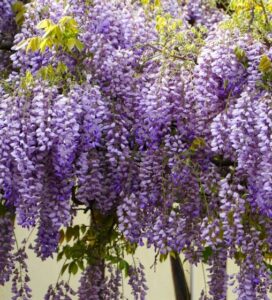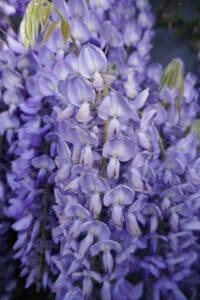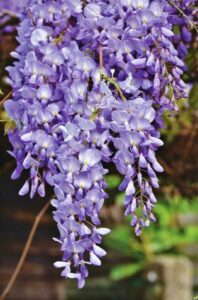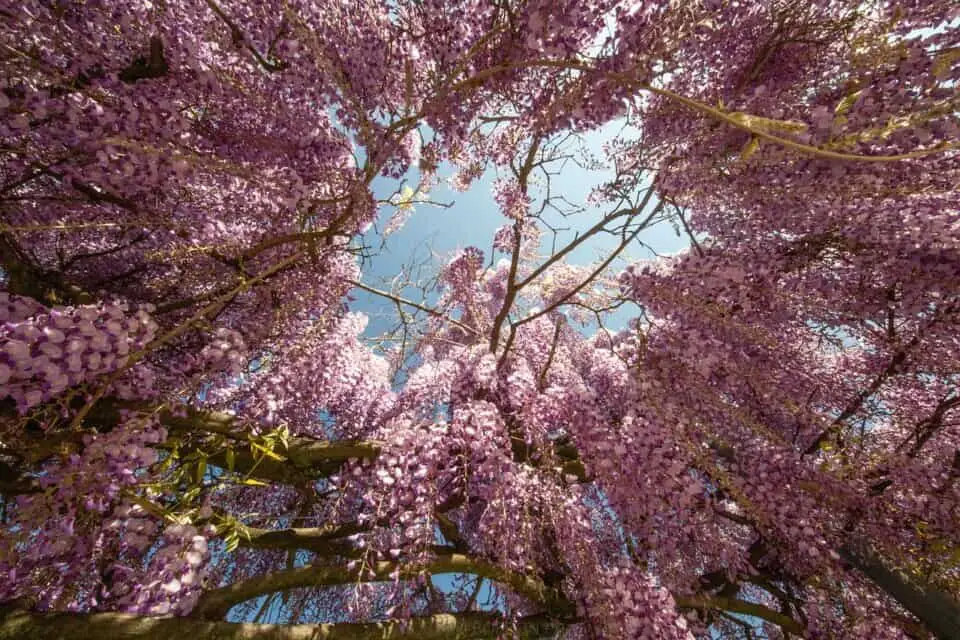Some links in the post are affiliate links and I get a commission from purchases made through some links found in the post.
One thing I have come to learn (albeit slowly) about flowering plants is that they enjoy being in the sun.
If you want your plant to flower well and for longer, you must move it closer to the sun. But why? It comes down to the very nature of flowering plants – they need water, light, and nutrients to make food.
That is the food that gives them the energy to bud and finally produce flowers which pave the way for seeds. In all these processes, light is the key. The minute you deprive the plant of light, you halt one of these processes.
For example, if your wisteria does not get enough light in its growing season, it does not get the energy to bud, which means it will not flower. That stops all the resultant activities.
So, if your wisteria has not been flowering or has been growing slowly, you can already picture the issue.
This guide takes you through how much light your wisteria needs, how often you should expose it to light, and what kind of light works for this plant.
What Type of Light Does My Wisteria Need?
 Most wisteria species thrive in bright and direct light, equivalent to full sun exposure. That’s the type of light where no obstruction lies between the light source and the wisteria.
Most wisteria species thrive in bright and direct light, equivalent to full sun exposure. That’s the type of light where no obstruction lies between the light source and the wisteria.
As such, the shadow cast by the plant is evident. Under such light, the wisteria can photosynthesize well enough to make food, giving it the energy to keep growing.
In such circumstances, the American wisteria varieties can grow as long as 30 feet long outdoors! And the Chinese varieties can reach lengths of 25 feet!
While wisterias do well in bright and direct light, they can also tolerate bright and indirect light. That kind of light does not hit the plant directly but is enough to cast a shadow behind the plant.
It’s also referred to as partial shade/ filtered light/ dappled light. A good example would be a wisteria that grows indoors near an east-facing window.
It does not receive bright and direct light but can still survive. Flowering in such a position is not optimal, and you can expect fewer flowers from your wisteria.
Can your wisteria do well in medium or low indirect light? The plant would not flower in such light as it would not have enough energy to support blooming.
Thus, you must keep the plant in bright and direct light or bright and indirect light if you want it to flower.
How Much Light Does a Wisteria Need?
Drumrolls, please – a wisteria needs as much light as it can get! The wisteria is not choosy about light exposure and prefers to be in full sun during its active growing season.
Ensure it gets at least 6 hours of exposure to bright and direct light in its active growing season. Only then can it produce enough leaves to support the growth of its vines and the development of healthy blooms.
What Happens If Your Wisteria Gets Too Little Light?
The wisteria prefers to be in the full sun. While some species can still do well in partial shade, you will know that it’s time to relocate them if:
1) Your Wisteria Does Not Flower
Wisterias are known for their beautiful clusters of fragrant flowers, which feature bold colors. Their beauty is one of the reasons people go for these plants, which have a twining growth pattern.
Thus, light could be the issue if you have a mature plant that does not flower. Without adequate access to light, the plant cannot make enough food to support flower production.
However, I would like to point out that some wisteria species can take up to two decades to mature enough to produce flowers. So, it could also be that the plant is too young to produce flowers.
2) Your Wisteria Has Sparse Growth
Wisteria leaves may not be the most pronounced leaves you will ever come across. But they are not sparse either.
So, an easy way to check if your plant has enough access to light would be to inspect its leaves. Are they growing far apart?
Are the vines of the plant growing long and thin? Is the elongation coupled with adequate leaf production, or do the vines appear bare? Bare vines signify that the plant is trying to reach more light.
And to do so, the plant forgoes the production of leaves (which support healthy growth) and instead focuses on elongating its vines to reach more light.
If you notice such a change in your wisteria’s growth, it may be time to move it to a better location.
3) Your Wisteria Grows Towards the Light
These climbing vines only do well in the presence of light. Thus, you may notice that they are trying to access more light by climbing over surrounding surfaces even more.
An easy way to check if light is the issue is to look at the nature of the vines facing the light and those underneath.
If some appear healthier and have much more vigorous growth than the others, you can tell that one side has more access to light than the other.
4) Your Wisteria Has Slow Growth
Sometimes, your wisteria may not even have enough energy to elongate its vines to reach the light. So, it will slow down or not grow even in its active growing season.
It’s easy to tell if there’s an issue with your wisteria because it grows so fast that some species are even considered invasive.
That means that if your plant is not growing and has access to water and fertilizer, light is the likely issue here.
5) Your Wisteria Has Small Leaves
Given that the vines will spend more energy growing longer to reach the light, their leaves will suffer the effect of this.
Not only will they be sparser, but they will also be smaller. Please note that this also impedes the plant’s ability to make food, which affects its flower production.
6) Your Wisteria Grows in Damp Soil
 The wisteria prefers regular watering and does well in moist soil. Even so, the soil should dry out between the waterings to prevent the occurrence of waterlogging.
The wisteria prefers regular watering and does well in moist soil. Even so, the soil should dry out between the waterings to prevent the occurrence of waterlogging.
If you notice that the soil takes too long to dry out even when it’s not raining, and you have not watered the plant, your wisteria likely needs more access to light.
In any of these cases, poor watering and poor feeding schedules can also be to blame. But if these are not the issues behind these adverse changes, you will need to pay more attention to the wisteria.
You may also like: The common problems with a wisteria & how to fix them
What Happens If Your Wisteria Gets Too Much Light?
There’s this common notion that the wisteria cannot get enough light. And in most instances, this can be the case. Your wisteria may exhibit the following signs if it gets too much sun exposure:
1) Your Wisteria’s Leaves Could Turn Yellow or Brown
Every winter, your wisteria goes dormant, and this is often preceded by its leaves turning yellow in the fall before they fall off.
As such, if you notice any browning in the fall or even late summer, that’s just part of the cycle.
However, if the leaves start turning brown or yellow in the spring or the start of summer, too much sun exposure can be to blame.
Please note that this often happens when the plant does not have adequate access to water. As a result, it loses more water to the environment than it takes up through its roots.
The leaves thus start suffering damage and take on yellow or pale color before browning. The best way to deal with this is to water your wisteria more often.
2) Your Wisteria’s Leaves May Fall Off
If your wisteria starts losing its leaves in its active growing season, that’s not good. It robs it of the chance to make enough food. So, how can the sun cause leaf loss in your wisteria?
It comes down to heat stress. If the plant loses water to the environment faster than it absorbs moisture from the soil, its leaves suffer the brunt of this.
The best way to avoid this is to water the plant often. Also, adding mulch to the base of the plant allows it to retain more water in the hot season.
You should not worry too much about changes that result from too much sun exposure. Most of these effects go away on their own soon enough.
But to be safe, pay attention to how often you water your plant to enable it to keep up with the summer heat.
You may also like: 6 great benefits of owning a wisteria
Where To Place Your Wisteria to Get The Best Light
As we have uncovered, your wisteria would rather have the summer heat wearing it down than be in the shade, cooling off from the heat waves. So, which are the best spots to have your plant?
1) Towards the east of your garden or against an east-facing window
This spot receives bright and direct light for several hours in the morning. Then it gets access to bright and indirect light for the rest of the day.
Ideally, you should only place growing wisterias in these conditions. Those that have matured are better off in southern spots, as I will cover later.
2) Towards the west of your garden or against a west-facing window in your home
Like east-facing spots, these positions also receive direct sun for a few hours each day. However, the sun, in this case, is the afternoon sun which can be harsh.
But if you water the plant adequately, that should not be an issue. The plant will enjoy the direct light for a few hours and indirect light for the rest of the day. These positions are also best for younger plants that are yet to start flowering.
3) Towards the south of your garden or against a south-facing window indoors
South-facing spots receive bright and direct light all day. This kind of exposure enables your wisteria to develop healthy leaves that are instrumental in developing healthy blooms.
Thus, any flowering wisteria should be in such a position during spring and summer.
If you’re planting your wisteria in a pot, you can play around with the positions as it grows.
But if you will plant it in the ground, I advise you to stick to the south of the garden. That will ensure it gets enough sun exposure when it finally starts flowering.
You may also like: Wisteria vs lilac
Can Wisterias Grow in Artificial Light?
Indoor conditions are not always favorable to these light-loving plants. After all, your south-facing window may not have as much access to light as the south of your garden has.
How can you navigate this issue without missing out on the spectacular wisteria blooms? – By using artificial lights on your plant.
How To Grow a Wisteria Using an Artificial Light
 Keeping a wisteria alive indoors is surprisingly easy due to the sturdiness of the plant. So, what will you need?
Keeping a wisteria alive indoors is surprisingly easy due to the sturdiness of the plant. So, what will you need?
- You must choose a full-spectrum light that features red and blue wavelengths as these are responsible for foliage and flower development,
- You can choose any artificial lights, including LEDs, incandescent bulbs, fluorescent lights, halogen bulbs, etc.
- You must position the lights at least 6 inches away from the wisteria to avoid exposing it to too much light. And for lights with high heat emission (like incandescent bulbs), play it safe with at least 24 inches of space between the lights and the plant.
- During the summer, leave the light on for at least 8 hours a day. Then as the plant nears its dormant phase, cut back on light slowly till you get to about 4 hours a day. The plant will not grow in the winter, but the light is there to mimic the natural light outdoors in the winter.
Ensure your plant still gets enough water and nutrients to enable it to have the energy to produce leaves and flowers.
You may also like: Wisteria tree vs vine
Final Thoughts
Most wisteria species do well in bright and direct light, as these conditions make it easier for them to produce food and support flower development.
However, some species, like the Chinese wisteria, can tolerate partial shade. Even so, you are better off placing the plant in the full sun and only moving it if it shows signs of too much sun exposure.
The goal here is to get a full bloom, which is only possible if your plant is not busy compensating for the absence of adequate light.
Happy Gardening!


